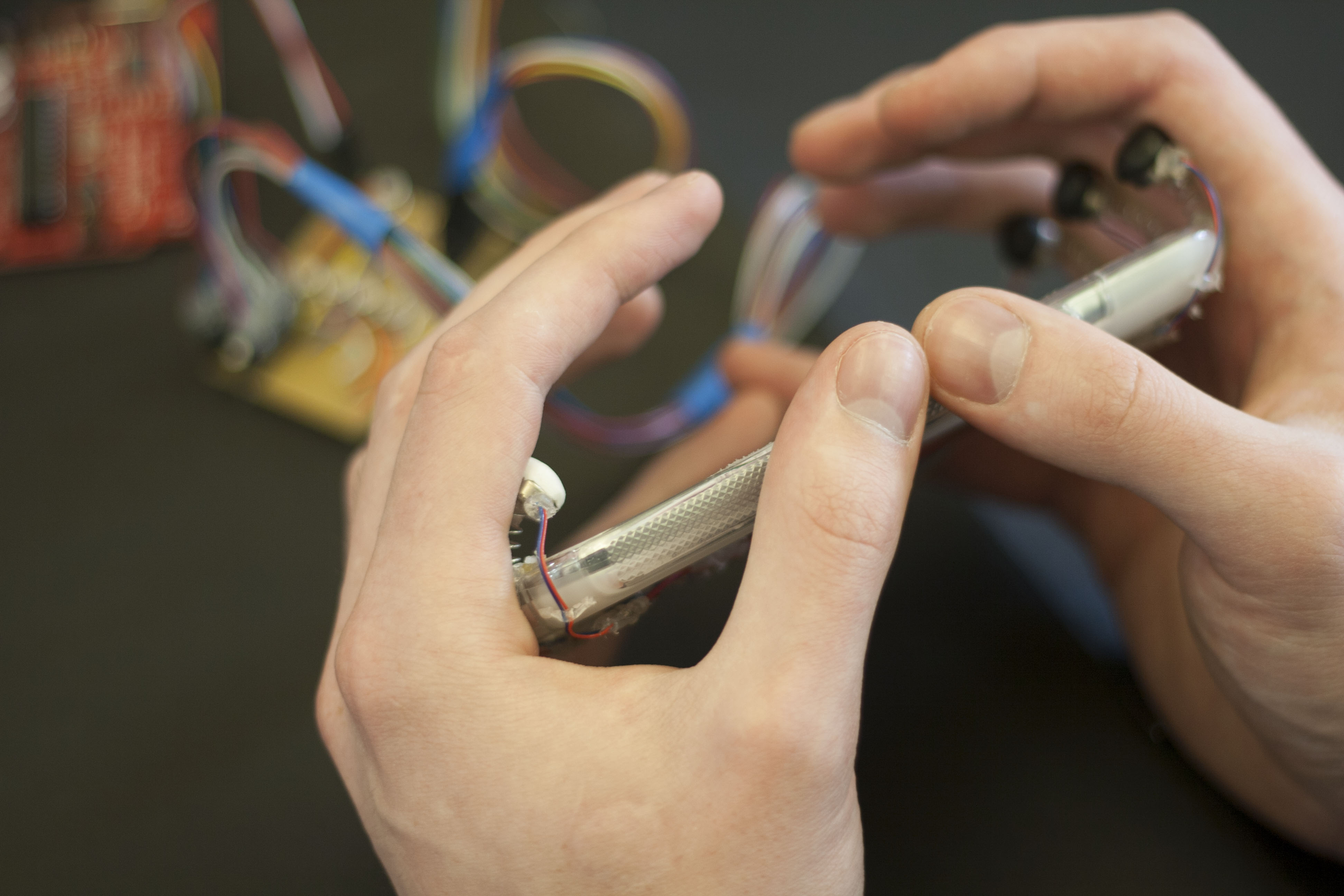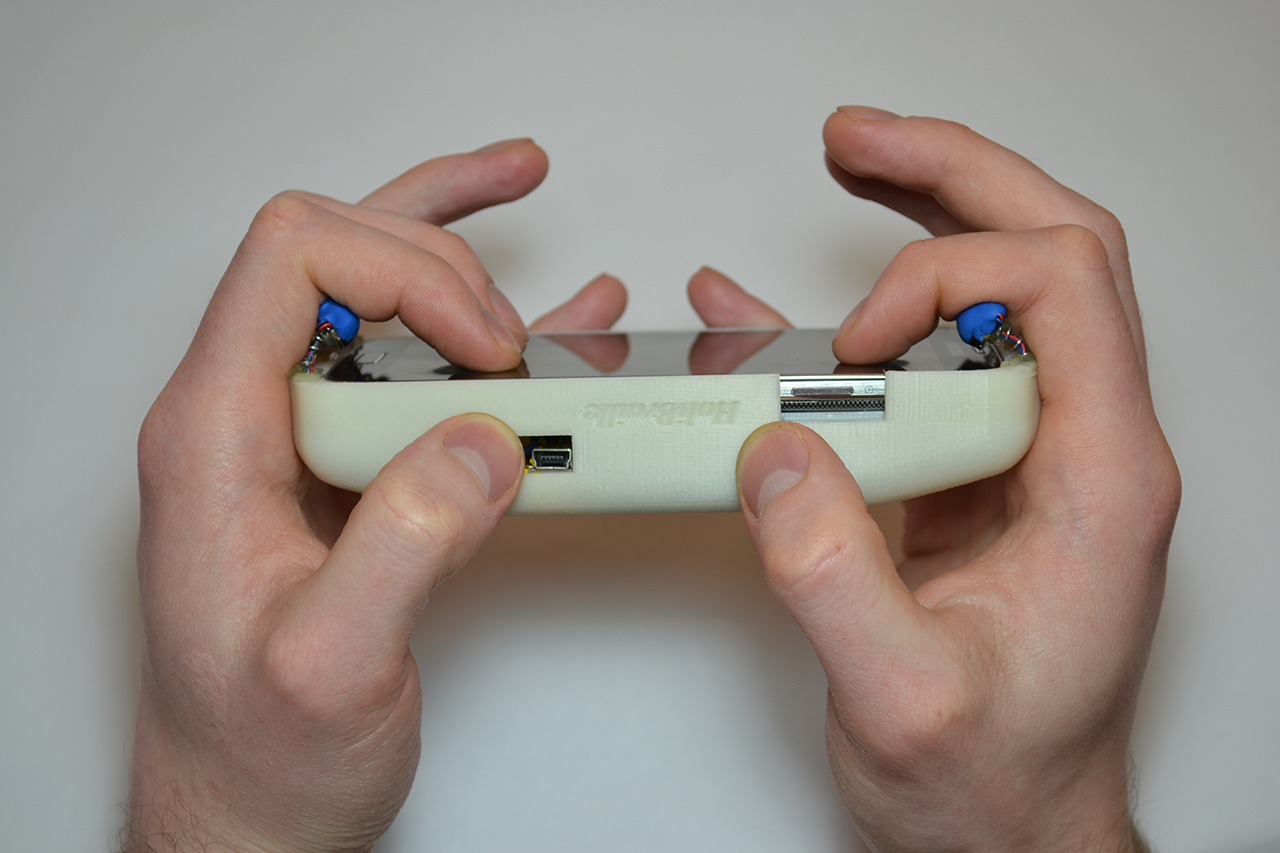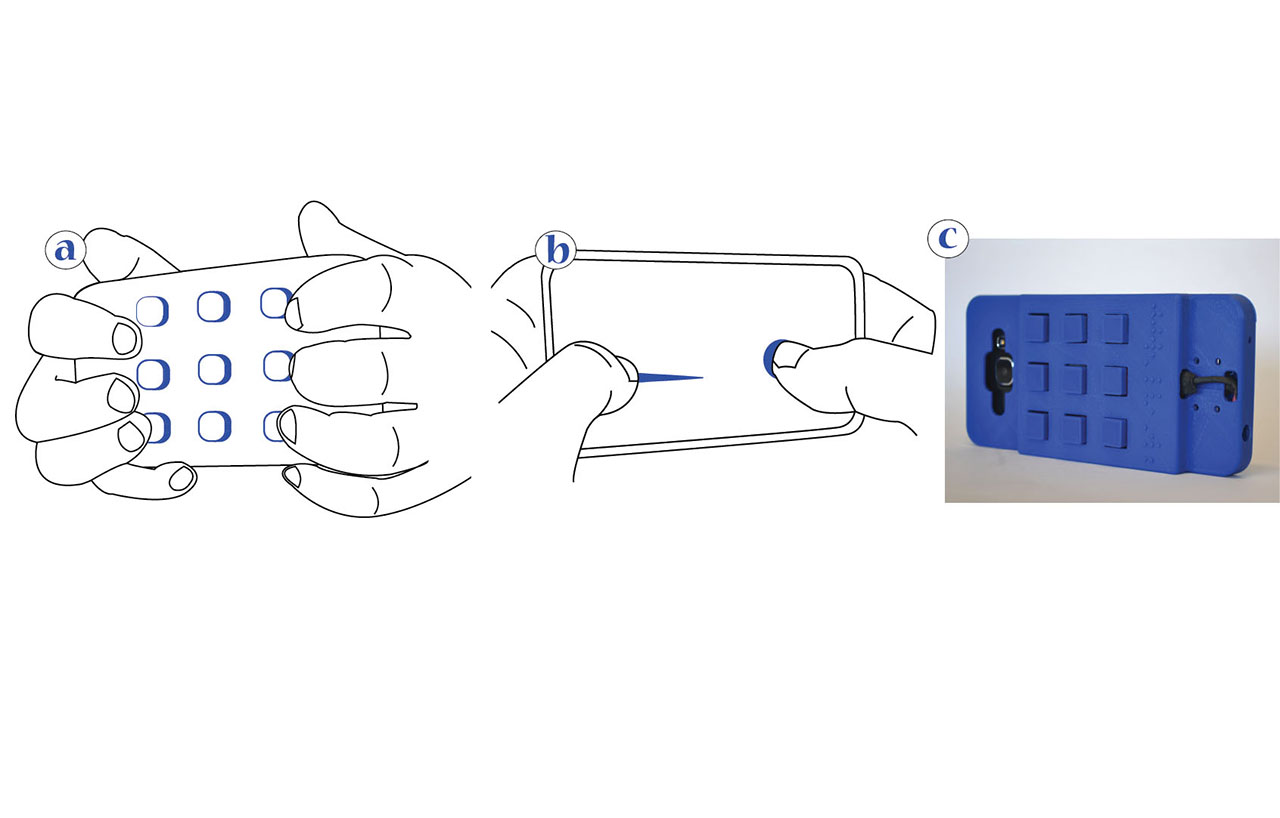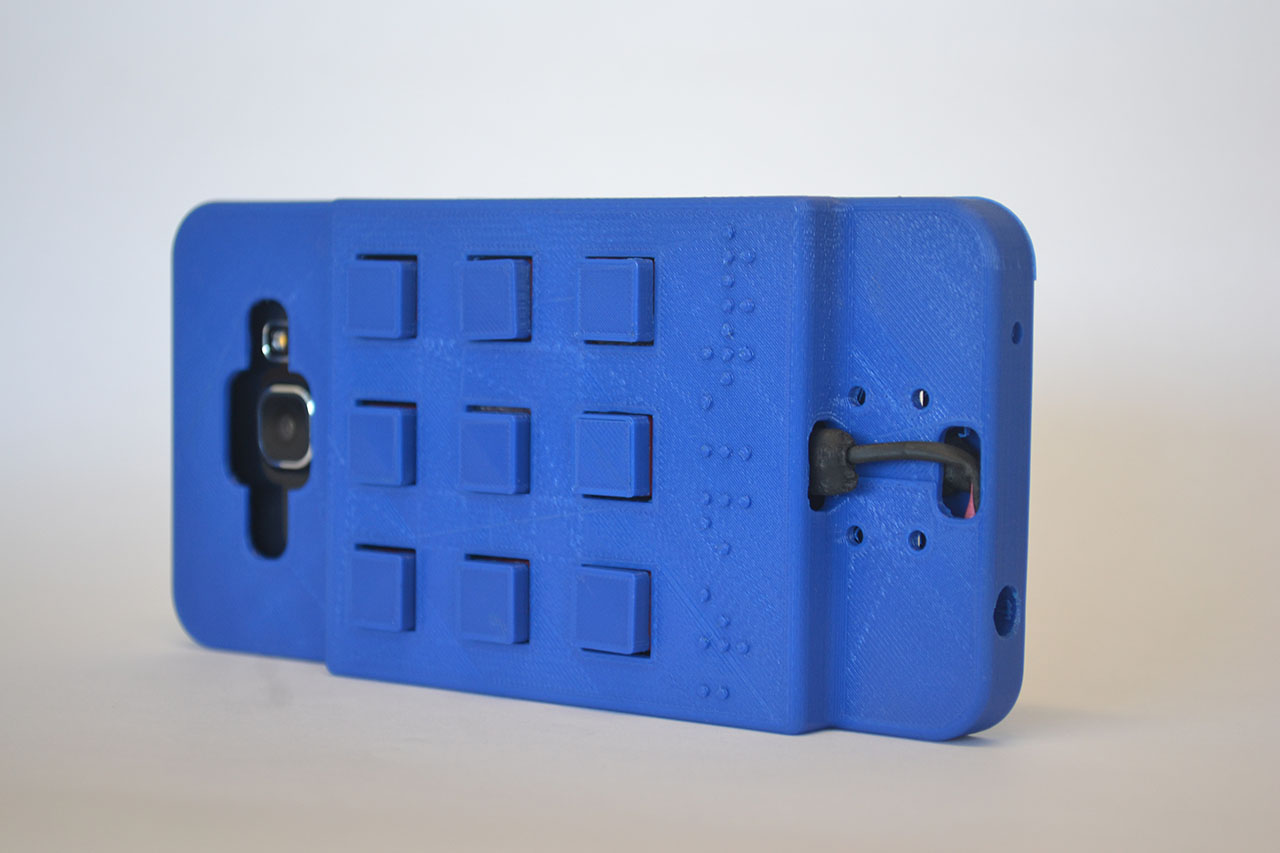Braille literacy is critical to the success and autonomy of blind people; there is a direct correlation between Braille literacy and succeeding in the work place. Learning to read and write is fundamental in for an independent way of living and is paramount to full and equal participation in society.
Braille 21 is an umbrella term for a series of research projects that aim to bring Braille to the 21st century. Our goal is to facilitate access to Braille in the new digital era. We are creating novel methods for writing and reading Braille using mobile and wearable technologies.
Project Details
Title: Braille 21
Date: Jan 1, 2017
Authors: Hugo Nicolau, Tiago Guerreiro, Kyle Montague, João Guerreiro, Vicki L. Hanson
Keywords: braille, literacy, technology, mobile, wearables
Related Publications
- Hybrid-Brailler: Combining Physical and Gestural Interaction for Mobile Braille Input and Editing
- Daniel Trindade, André Rodrigues, Tiago Guerreiro, and Hugo Nicolau. 2018. Hybrid-Brailler: Combining Physical and Gestural Interaction for Mobile Braille Input and Editing. Proceedings of the 2018 CHI Conference on Human Factors in Computing Systems, ACM, 27:1–27:12. http://doi.org/10.1145/3173574.3173601
- [ABSTRACT] [PDF] [LIBRARY] [VIDEO]
Braille input enables fast nonvisual entry speeds on mobile touchscreen devices. Yet, the lack of tactile cues commonly results in typing errors, which are hard to correct. We propose Hybrid-Brailler, an input solution that combines physical and gestural interaction to provide fast and accurate Braille input. We use the back of the device for physical chorded input while freeing the touchscreen for gestural interaction. Gestures are used in editing operations, such as caret movement, text selection, and clipboard control, enhancing the overall text entry experience. We conducted two user studies to assess both input and editing performance. Results show that Hybrid-Brailler supports fast entry rates as its virtual counterpart, while significantly increasing input accuracy. Regarding editing performance, when compared with the mainstream technique, Hybrid-Brailler shows performance benefits of 21% in speed and increased editing accuracy. We finish with lessons learned for designing future nonvisual input and editing techniques.
- HoliBraille: Multipoint Vibrotactile Feedback on Mobile Devices
- Hugo Nicolau, Kyle Montague, Tiago Guerreiro, André Rodrigues, and Vicki L. Hanson. 2015. HoliBraille: Multipoint Vibrotactile Feedback on Mobile Devices. Proceedings of the 12th Web for All Conference, ACM, 30:1–30:4. http://doi.org/10.1145/2745555.2746643
- [ABSTRACT] [PDF] [LIBRARY]
We propose HoliBraille, a system that enables Braille input and output on current mobile devices. We use vibrotactile motors combined with dampening materials in order to actuate directly on users’ fingers. The prototype can be attached to current capacitive touchscreen devices enabling multipoint and localized feedback. HoliBraille can be leveraged in several applications including educational tools for learning Braille, as a communication device for deaf-blind people, and as a tactile feedback system for multitouch Braille input. We conducted a user study with 12 blind participants on Braille character discrimination. Results show that HoliBraille is effective in providing localized feedback; however, character discrimination performance is strongly related with number of simultaneous stimuli. We finish by discussing the obtained results and propose future research avenues to improve multipoint vibrotactile perception.
- B#: Chord-based Correction for Multitouch Braille Input
- Hugo Nicolau, Kyle Montague, Tiago Guerreiro, João Guerreiro, and Vicki L. Hanson. 2014. B#: Chord-based Correction for Multitouch Braille Input. Proceedings of the 32Nd Annual ACM Conference on Human Factors in Computing Systems, ACM, 1705–1708. http://doi.org/10.1145/2556288.2557269
- [ABSTRACT] [PDF] [LIBRARY]
Braille has paved its way into mobile touchscreen devices, providing faster text input for blind people. This advantage comes at the cost of accuracy, as chord typing over a flat surface has proven to be highly error prone. A misplaced finger on the screen translates into a different or unrecognized character. However, the chord itself gathers information that can be leveraged to improve input performance. We present B#, a novel correction system for multitouch Braille input that uses chords as the atomic unit of information rather than characters. Experimental results on data collected from 11 blind people revealed that B# is effective in correcting errors at character-level, thus providing opportunities for instant corrections of unrecognized chords; and at word-level, where it outperforms a popular spellchecker by providing correct suggestions for 72% of incorrect words (against 38%). We finish with implications for designing chord-based correction system and avenues for future work.
- UbiBraille: Designing and Evaluating a Vibrotactile Braille-reading Device
- Hugo Nicolau, João Guerreiro, Tiago Guerreiro, and Carriço Luı́s. 2013. UbiBraille: Designing and Evaluating a Vibrotactile Braille-reading Device. Proceedings of the 15th International ACM SIGACCESS Conference on Computers and Accessibility, ACM, 23:1–23:8. http://doi.org/10.1145/2513383.2513437
- [ABSTRACT] [PDF] [LIBRARY]
Blind people typically resort to audio feedback to access information on electronic devices. However, this modality is not always an appropriate form of output. Novel approaches that allow for private and inconspicuous interaction are paramount. In this paper, we present a vibrotactile reading device that leverages the users’ Braille knowledge to read textual information. UbiBraille consists of six vibrotactile actuators that are used to code a Braille cell and communicate single characters. The device is able to simultaneously actuate the users’ index, middle, and ring fingers of both hands, providing fast and mnemonic output. We conducted two user studies on UbiBraille to assess both character and word reading performance. Character recognition rates ranged from 54% to 100% and were highly character- and user-dependent. Indeed, participants with greater expertise in Braille reading/writing were able to take advantage of this knowledge and achieve higher accuracy rates. Regarding word reading performance, we investigated four different vibrotactile timing conditions. Participants were able to read entire words and obtained recognition rates up to 93% with the most proficient ones being able achieve a rate of 1 character per second.
- Augmenting Braille Input Through Multitouch Feedback
- Hugo Nicolau, Kyle Montague, João Guerreiro, et al. 2013. Augmenting Braille Input Through Multitouch Feedback. Proceedings of the Adjunct Publication of the 26th Annual ACM Symposium on User Interface Software and Technology, ACM, 81–82. http://doi.org/10.1145/2508468.2514720
- [ABSTRACT] [PDF] [LIBRARY]
Current touch interfaces lack the rich tactile feedback that allows blind users to detect and correct errors. This is especially relevant for multitouch interactions, such as Braille input. We propose HoliBraille, a system that combines touch input and multi-point vibrotactile output on mobile devices. We believe this technology can offer several benefits to blind users; namely, convey feedback for complex multitouch gestures, improve input performance, and support inconspicuous interactions. In this paper, we present the design of our unique prototype, which allows users to receive multitouch localized vibrotactile feedback. Preliminary results on perceptual discrimination show an average of 100% and 82% accuracy for single-point and chord discrimination, respectively. Finally, we discuss a text-entry application with rich tactile feedback.
- The Today and Tomorrow of Braille Learning
- J. Guerreiro, D. Gonçalves, D. Marques, T. Guerreiro, H. Nicolau, and K. Montague. 2013. The Today and Tomorrow of Braille Learning. Proceedings of the 15th International ACM SIGACCESS Conference on Computers and Accessibility, ACM, 71:1–71:2. http://doi.org/10.1145/2513383.2513415
- [ABSTRACT] [PDF] [LIBRARY]
Despite the overwhelming emergence of accessible digital technologies, Braille still plays a role in providing blind people with access to content. Nevertheless, many fail to see the benefits of nurturing Braille, particularly given the time and effort required to achieve proficiency. Our research focuses on maximizing access and motivation to learn and use Braille. We present initial insights from 5 interviews with blind people, comprising of Braille instructors and students, where we characterize the learning process and usage of Braille. Based on our findings, we have identified a set of opportunities around Braille education. Moreover, we devised scenarios, and built hardware and software solutions to motivate discovery and retention of Braille literacy.
- BrailleType: Unleashing Braille over Touch Screen Mobile Phones People’s Choice Award
- João Oliveira, Tiago Guerreiro, Hugo Nicolau, Joaquim Jorge, and Daniel Gonçalves. 2011. BrailleType: Unleashing Braille over Touch Screen Mobile Phones. In Human-Computer Interaction – INTERACT 2011: 13th IFIP TC 13 International Conference, Lisbon, Portugal, September 5-9, 2011, Proceedings, Part I, Pedro Campos, Nicholas Graham, Joaquim Jorge, Nuno Nunes, Philippe Palanque and Marco Winckler (eds.). Springer Berlin Heidelberg, Berlin, Heidelberg, 100–107. http://doi.org/10.1007/978-3-642-23774-4_10
- [ABSTRACT] [PDF] [LIBRARY]
The emergence of touch screen devices poses a new set of challenges regarding text-entry. These are more obvious when considering blind people, as touch screens lack the tactile feedback they are used to when interacting with devices. The available solutions to enable non-visual text-entry resort to a wide set of targets, complex interaction techniques or unfamiliar layouts. We propose BrailleType, a text-entry method based on the Braille alphabet. BrailleType avoids multi-touch gestures in favor of a more simple single-finger interaction, featuring few and large targets. We performed a user study with fifteen blind subjects, to assess this method’s performance against Apple’s VoiceOver approach. BrailleType although slower, was significantly easier and less error prone. Results suggest that the target users would have a smoother adaptation to BrailleType than to other more complex methods.



